Mali, the land of emperors, epic landscapes, and the captivating pulse of West Africa, often sparks curiosity laced with a touch of apprehension. Headlines can paint a picture of a nation grappling with security concerns, deterring some travelers from exploring its rich offerings. But for those willing to venture beyond the headlines, Mali offers an unforgettable experience, brimming with cultural treasures, breathtaking scenery, and the warmth of its people.
There are many things to consider before embarking on an off the beaten path country like, Mali. Here we share all the tidbits that helped us get to the destinations that we wanted to go to while staying as safe as we could.
Logistics
There are many things to research prior to embarking on a trip to Mali. We have put together some of the more important logistics that you may want to consider to help with your planning.
SAFETY
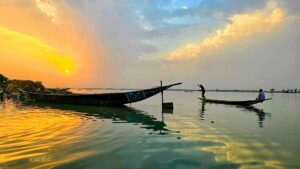
As I write this, I reflect on the warmth of the people in this gorgeous country. There was never a moment where we did not feel safe. The people of Mali were incredibly welcoming, generous and helpful. However, prior to embarking on this type of adventure, it is crucial to be aware of the potential risks.
When we visited and at the time of writing, all travel advisories (Canada, USA, Australia, etc.,) where at the highest level – Do Not Travel. This is due to the potential risk of terrorism and kidnapping in this country. We were aware of this and made a conscious decision based on the information that we had from our guide, trusted news channels and our tolerance for risk.
I mean hey, we have visited some risky places, including Afghanistan and Mali. All of these quests were based on deep research, conversations with people on the ground balanced with our sense for adventure.
Ultimately, the decision to travel to Mali (or any other potentially risky travel destination) rests with you and your personal tolerance for risk.
CURRENCY
Mali uses the West African CFA Franc. This currency is shared by eight West-African nations: Benin, Burkina Faso, Ivory Coast, Guinea-Bissau, Mali, Niger, Senegal, and Togo. The CFA is quite stable as it is now pegged to the Euro.
At time of writing, the 1000 CFA was worth $1.64 USD.
TOURIST VISA
A tourist visa is required for most visitors, especially those from the west. There are a couple of options to receive the visa:
- You can apply for the Mali tourist visa at a Mali Embassy in your home country. This option usually takes an extended period of time and can be a costly option.
- You can also get a visa while visiting one of the other capitals of West Africa, which may prove cheaper. For example, there is a Mali Embassy in Abidjan, Côte d’Ivoire. The cost of getting a tourist visa there, was 45,000 CFA /per person (approximately $74 USD). In addition, they wanted a “gift”. As Rob got malaria during our first trip to West Africa, we had to get a second visa for our second trip. We received this one in Luanda Angola, where the process was lovely and no one wanted gifts! The cost was 63,000 CFA/per person (approximately $103 USD).
CONNECTIVITY: SIM/ESIM CARDS
We purchased an eSIM card from Manet Travel online. The cost for 2 Gb of data was $11.76 USD and it worked well including some of our more rural destinations. But for a tangible SIM card, we would recommend getting an Orange SIM. It has adequate coverage throughout most of the country. You can either buy the card at the airport upon arrival, at one of the Agence Orange brick and mortar shops, or with one of the many small kiosks throughout Bamako.
Make sure to have your passport with you to register and activate the card upon purchase.
Mali Guide/Driver
There are a number of guides and organizations that successfully operate in this country. However, given the added risk here, we wanted to go with someone who really knows the area and has connections to the government and the precarious day to day changes and safety measures required to be aware of here.
We can recommend these 2 options for guides:
- Papillon Reizen: Abdoulaye + 223 79 32 18 51
- Ibrahim (previous owner of Papillon Reizen): +223 76 02 15 43
Top Things to See and Do in Mali

As we mentioned previously, safety was always top of mind during our trip to this beautiful country. Unfortunately during our visit, the cities of Djenne and Mopti were off limits to tourists and we were unable to travel there. However, we were able to see very similar architecture by the same mud mosque architect who built the one in Djenne. Read on to find out where!
Bamako

Bamako, Mali’s bustling capital city, served as our jumping-off point for exploring the rest of the country. While undeniably energetic, Bamako is also dusty and congested, a stark contrast to the charm of the smaller towns. The city’s Grand Marche is a must for souvenir hunters and those who enjoy the thrill of the bargain. For a history buff fix, the National Museum offers a glimpse into Mali’s rich past.
Our Bamako accommodation, the Sleeping Camel (the former Moroccan Embassy), wasn’t the fanciest hotel, but it certainly had the most character. Squeezed between various embassies, the Sleeping Camel offers a unique atmosphere. While the rooms might not be luxurious, the food is some of the best in Bamako. The inner courtyard transforms into a vibrant hub in the evenings, with expats and locals alike gathering to enjoy delicious dishes, music, and good company.
After experiencing Bamako’s pulse, we set off to explore the true gems of Mali – Segou, San, and Siby – each offering a glimpse into the country’s rich culture and enchanting beauty.
Segou

From Bamako our journey continued 240 km north east to Segou. Segou is a charming city on the banks of the mighty Niger River. This was once the capital of the Bambara Empire, its legacy evident in the imposing mud-brick architecture. A boat trip on the Niger offers a glimpse into the city’s lifeblood, where fishermen cast their nets and colorful pirogues navigate the gentle current.
Segou is well know for it’s many handicraft traditions as well. Most of these amazing products are showcased every Monday at the Segou uber colorful weekly market (which we were so lucky to visit)! Some of these traditions include its vibrant mask-making craft . Workshops display the intricate craftsmanship that goes into creating these ceremonial masks, each with a unique story to tell.
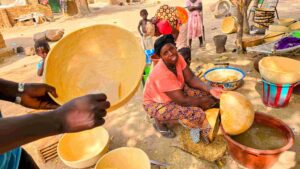
There is a village that makes beautiful bowls and spoons from calabash that they decorate and engrave. Our guide took us into the village where we were able to watch these gorgeous items being made. Brides order a set of these calabash, engraved with their new family name.
Another village (on the island) on the Niger River weaves baskets and mats. Another village makes pottery and then ships the heavy load down the river to the market. The colors of this town are dazzling and amazing. We highly recommend that you visit on a Monday to see all of these handicrafts on display.
One of the must stops in Segou is Ibrahim’s Cafe (Cafeteria Djigui-Bombo) that serves fabulous coffee, sells some genuine Dogon souvenirs and does all of this in a totally chill vibe inside of a mud structure set to music. Ibrahim is one of the guides that we highly recommend. This cafe used to be the headquarters for Papillon Reizen, which he used to own.
Old Segou
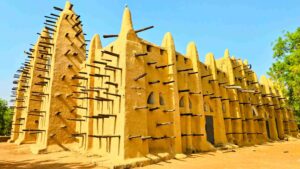
Just south of Segou proper, is the Old Segou which is home to a small village containing the Royal Palace of the Bamanam Kingdom. In total, there are three monuments to visit. We started at the palace where the Tomb of King Biton is located. Many children ran after us, as a local guide explained the great significance of the Bamanam Kingdom and King Biton.
Then we went to the first Mosque (made of mud) which was ever built by a Syrian. And lastly, as even more curious smiling children appeared, we ended up at the mosque built for the King’s mother. The King did not want his mother to walk so far to pray, so he built her a mosque closer to her home.
San
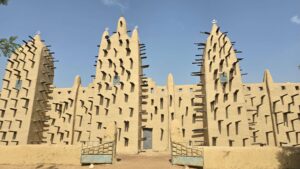
While the Great Mosque of Djenne may not be accessible during these times, the Great Mosque of San was possible to visit. Built by the same architect as it’s slightly bigger version in Djenne, the San version is a masterpiece of Sudano-Sahelian architecture and is a must visit as well!
We were greeted by the imam of the mosque and were shown around by him and his 6 year old son. Inside, the mosque is divided by long thick mud rows and is filled with carpets covering the floor,
The imam took us upstairs onto the rooftop of the mosque and allowed us to walk around the stunning structure. Given that we were barefoot, our feet got incredibly hot, trying to gingerly walk from one end to the other, taking pauses at every shady spot.
Siby
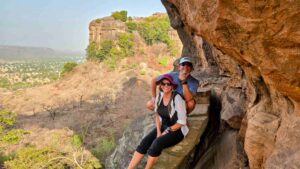
Just 50 km southwest of the capital is Siby – a charming village waiting to be explored. It’s an easy escape from the city bustle. Siby is surrounded by beautiful scenery – rolling hills, rocky ridges, and even some caves! Hiking enthusiasts can challenge themselves with a trek to the arch, a natural rock formation that rewards climbers with stunning views.
For those who prefer a slower pace, the village itself is a delight. Wander the streets and admire the brightly painted houses that add a pop of color to the landscape. If you’re looking to stay a while or just need a delicious meal, the Auberge de l’Arche is a great option.
Djenne

Standing tall in Djenné, is the Great Mud Mosque, which is a wonder of Africa and a masterpiece of Sudano-Sahelian architecture. This massive mud-brick structure, the largest in the world, dominates the city’s skyline. Imagine arriving from the low-rise houses of Djenné and encountering this towering giant!
Founded between 800 and 1250 AD, Djenné thrived as a center of trade, learning, and Islam. The Great Mosque, built soon after, became a symbol of both local power and, later on, French colonialism (1892). For centuries, it has been the heart of religious and cultural life for Mali and Djenné. Each year, the community comes together for a unique festival: the plastering of the Great Mosque.
Tourists might be surprised by the Great Mosque. While it’s a UNESCO World Heritage Site, it’s not as old as you might think. The original mosque crumbled by the 1800s and was later torn down. The current structure, built in 1907 during French colonial rule, reflects French design trends rather than ancient tradition. Though the local chief mason used traditional materials, the overall style follows a “neo-Sudanese” look favored by the French for their West African colonies.
Mopti

While currently off-limits due to safety concerns, Mopti is a fascinating city in Mali, nicknamed the “Venice of Mali” for its location on three islands along the Niger River. The old town, built with traditional mud houses, boasts a lively market where you can put your bartering skills to the test.
Mopti is the legendary entry point to the Bandiagara Cliffs which is Dogon Country. One can hike through here for days traveling from one Dogon Village to the next.
Timbuktu
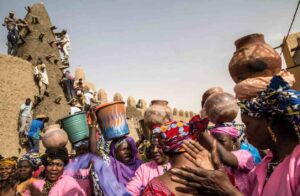
Timbuktu earned its UNESCO World Heritage status thanks to its remarkable past as a center of learning and religion in Africa during the 15th and 16th centuries. This ancient city thrived due to its location at a crossroads of trade routes across the Sahara Desert. Gold was a major draw, attracting Muslim scholars and scribes from all corners of the Islamic world.
These scholars brought their knowledge and manuscripts, establishing Timbuktu as a hub of learning where information was exchanged and preserved. Sadly, many of the city’s treasures, including 13th-century mausoleums, have been damaged or destroyed.
Top Sights in Timbuktu:
1. Djinguereber Mosque: This historic mosque was built in 1325 and once housed the world’s largest library!
2. Mosque of Sankore: Another architectural gem that served as a center of learning and intellectual exchange
3. Sidi Yahya Mosque: A mosque which was completed in 1440
However, given the difficulty of traveling to Timubuktu, I was advised to temper my expectations. When Bob Geldof visited Timbuktu, his famous words were:”That’s it?”. Indeed, “That’s it?” is generally the feeling a lot of people have shared with us after they have gotten there. It’s a small sleepy town of adobe buildings. The famous sites can easily be seen in a day. The famed university is a simple unadorned adobe building. It hasn’t been used in centuries.
Timbuktu is currently accessible only by plane from Bamako. Abdoulaye of Papillon Reizen (one of the guides that we recommend above) does take clients to his home town of Timbuktu. The options are either a 3 day trip or a charter flight (15 people), to land in Timbuktu for a few hours of sightseeing.
Wrap Up

For us, our adventure through Mali was a wonderful surprise. Not only did we feel safe there, but we also delighted in the treasures that we were privileged to see and experience. This is a country that has been through so much and yet, the people continue to be warm and welcoming despite their difficulties and the current situation.
Traveling through Segou, San, Siby and the small villages around the country showed us the true beauty of Mali’s nature, history, culture and people.
Have you been to Mali or any of the other off the beaten path destinations? We would love to hear from you in the comments.

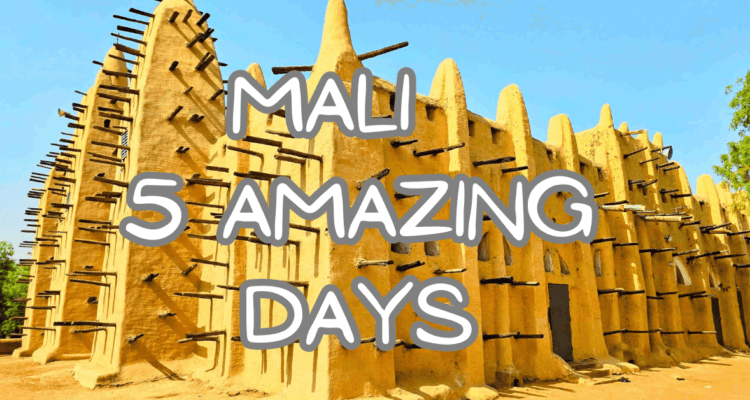
1 Comment